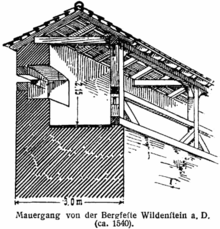Battlement
With battlements , fortified structures such as B. castles , fortresses , fortified churches or fortified monasteries denotes the upper end of a defensive wall or a defensive tower in the form of a corridor for defenders. It can be made of wood or stone. In smaller Roman forts , battlements occasionally consisted only of an earth wall piled up on the inside of the wall, while corridors on or along city walls were also called guard walks .
variants
In the case of narrow walls, battlements protrude inward to create sufficient width for two people to pass each other. The protruding part of the corridor can be supported by wooden struts, corbels or by arcades . On the outside, battlements are usually flush with the wall.
To protect the defenders, battlements are provided with a wooden or stone parapet , which is often equipped with battlements and loopholes . As weather protection and for the purpose of covering from above, battlements often also have a canopy in the form of a shed or gable roof . The oldest evidence of such roofing dates back to the 14th century. On the inside, high battlements are usually provided with wooden railings, more rarely also closed by wood or half-timbering .
In the late Middle Ages , ramparts protruding outwards (or on both sides) were more common. In this way, stone parapets can be equipped with machiculis (rows of throwing holes) on the underside , with whose help attacking enemies at the foot of the wall can be fought. The term murder gang is also used for this construction method.
A hurdle that protrudes outwards as a covered wooden structure has the same function .
Multi-storey battlements often appear in high walls.
Open battlement with battlements (Castelo de Almourol, Portugal )
Open battlements made of wood on the city wall of Delitzsch
Covered battlement on the city wall of Worms , city side
Stone battlements on consoles ( old water art in Bautzen )
Saint-Sardos , Tarn-et-Garonne , church facade with battlement
Hurdles on the tower and on the top of the wall (reconstruction by Eugène Viollet-le-Duc )
literature
- Reinhard Friedrich: battlements. In: Horst Wolfgang Böhme , Reinhard Friedrich, Barbara Schock-Werner (Hrsg.): Dictionary of castles, palaces and fortresses . Philipp Reclam, Stuttgart 2004, ISBN 3-15-010547-1 , pp. 263-264, doi: 10.11588 / arthistoricum.535 .
- Friedrich-Wilhelm Krahe: Castles of the German Middle Ages. Floor plan lexicon. Flechsig, Würzburg 2000, ISBN 3-88189-360-1 , p. 20.
- Friedrich-Wilhelm Krahe: Castles and residential towers of the German Middle Ages. Volume 1. Thorbecke, Stuttgart 2002, ISBN 3-7995-0104-5 , pp. 26-27.
Web links
Individual evidence
- ↑ Hannah Kronschnabl: So far, the oldest covered battlement in Germany discovered in Memmingen. on all-in.de, accessed on September 27, 2019.
- ^ Stefan Uhl, Joachim Zeune: ring wall. In: Deutsche Burgenvereinigung e. V. (Ed.): Castles in Central Europe. Volume 1: Designs and Development. Theiss, Stuttgart 1999, ISBN 3-8062-1355-0 , p. 230.






